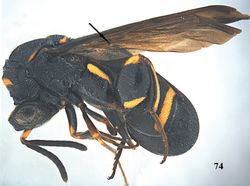Leucospis shaanxiensis
| Notice: | This page is derived from the original publication listed below, whose author(s) should always be credited. Further contributors may edit and improve the content of this page and, consequently, need to be credited as well (see page history). Any assessment of factual correctness requires a careful review of the original article as well as of subsequent contributions.
If you are uncertain whether your planned contribution is correct or not, we suggest that you use the associated discussion page instead of editing the page directly. This page should be cited as follows (rationale):
Citation formats to copy and paste
BibTeX: @article{Ye2017ZooKeys, RIS/ Endnote: TY - JOUR Wikipedia/ Citizendium: <ref name="Ye2017ZooKeys">{{Citation See also the citation download page at the journal. |
Ordo: Hymenoptera
Familia: Leucospidae
Genus: Leucospis
Name
Leucospis shaanxiensis Ye & van Achterberg & Yue & Xu, 2017 sp. n. – Wikispecies link – ZooBank link – Pensoft Profile
Type material
Holotype, ♀ (SCAU), CHINA, “Shaanxi, Liuba, 7.VIII.2015, Yi-cheng Li, No. 2016000020”.
Diagnosis
Body mainly black (Fig. 74), with exception of largely yellow antennal scape (Figs 75, 80), pronotum with wide yellow stripe (Fig. 76), mesoscutum with a pair of minute yellow spots submedially and a pair of yellow stripes laterally (Fig. 77), mesoscutellum with yellow stripe posteriorly (Fig. 77), wings largely dark brown, hind coxa with yellow stripe dorsally (Fig. 82), hind femur with yellow mark ventro-basally, and similar yellow mark apico-dorsally (Fig. 83), hind tibia mostly yellow dorsally, T1 with a pair of yellowish spots antero-dorsally, T4 with yellow stripe near anterior margin, T5 with yellow stripe near posterior margin (Figs 74, 78); pronotum with distinct discal carina and premarginal carina, first one arcuate, latter one straight; dorsellum without carinae, rounded posteriorly (Fig. 78); hind femur with fourteen teeth ventrally, forming a rather irregular row (Figs 74, 83); concavity below apical spine of hind tibia with slender spines and long setae (Fig. 83); T1 angularly protruding dorsally with ovipositorial furrow on top of it and laterally distinct smooth interspaces between coarse punctures (Fig. 78); ovipositorial furrow on T1 deep, single, and distinctly impressed on T4 (Fig. 78); T5 0.7 times dorsal length of T1 (Fig. 78); ovipositor sheath long, nearly reaching anterior margin of T1 (Fig. 78).
Description
Holotype. Female. Body length 15.0 mm. OOL = 2.5 POD; POL = 3.0 POD; MS = 1.9 POD.
Head. Coarsely and densely punctate, with dense and short pubescence (Figs 80, 81). Flagellomeres (except first segment) hardly narrowed basally (Figs 74, 75).
Mesosoma. Pronotum, mesoscutum, mesoscutellum, dorsellum, mesopleuron, metapleuron and propodeum coarsely and densely punctate, with dense short pubescence (Figs 74, 76–78). Discal carina and premarginal carina well developed, first one arcuate, latter one straight (Fig. 76). Dorsellum without carina, rounded posteriorly (Fig. 77). Hind coxa coarsely and densely punctate (but less densely dorsally), with short pubescence, with narrow smooth area and carinate postero-dorsally (Fig. 82). Hind femur with rather irregular row of fourteen teeth ventrally, basal one largest (Fig. 83). Hind tibia produced into a distinct spine ventro-apically, concavity below apical spine with slender spines and long setae (Fig. 83). Propodeum raised medially, with weak median carina (Fig. 78).
Metasoma. Coarsely and densely punctate, with dense short pubescence (Figs 74, 78). T1 little narrower than T4 or T5 in dorsal view (Fig. 78). Ovipositorial furrow deep on T1, T4 and T5 (Fig. 78). Ovipositor sheath long, almost reaching anterior margin of T1 (Fig. 78).
Colouration. Head black (Figs 80, 81). Antenna black, with scape yellow but base and apex blackish brown (Figs 75, 80). Pronotum with wide yellow arcuate stripe on discal carina, not reaching anterior corners (Fig. 76). Mesoscutum black, with a pair of minute obscure yellow spots submedially and a pair of narrow yellow stripes laterally (Fig. 77). Mesoscutellum black, with yellow arcuate stripe posteriorly (Fig. 77). Wings dark brown, but medially paler. Hind coxa black, with elongate yellow stripe dorsally (Fig. 82). Hind femur with elongate triangular yellow mark ventro-basally, and similar yellow mark apico-dorsally (Fig. 83). Hind tibia mostly yellow dorsally (Fig. 83). Metasoma black, T1 with a pair of yellowish spots antero-dorsally, T4 with medium-sized yellow stripe near anterior margin, T5 with broad yellow stripe near posterior margin; yellow stripe of T5 in lateral view much broader than apical black part (Figs 74, 78).
Male. Unknown.
Biology
Unknown. Collected in August.
Distribution
China (Shaanxi).
Etymology
Named after the province of the type locality.
Notes
Unfortunately, Leucospis shaanxiensis is described from a single specimen. We considered the possibility that it is an extreme variant of Leucospis aequidentata sp. n., but the number of small differences (both concerning morphology and colouration as indicated in the key) makes this unlikely.
Original Description
- Ye, X; van Achterberg, C; Yue, Q; Xu, Z; 2017: Review of the Chinese Leucospidae (Hymenoptera, Chalcidoidea) ZooKeys, (651): 107-157. doi
Images
|

